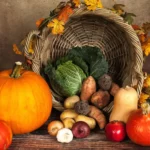From Yacon to Yukon Gold Potatoes, here is a list of vegetables that begin with the letter Y. In addition to listing the names of vegetables that start with the letter Y, we also include information, classifications, recipes, images, and more.
From Yams to Yardlong Beans: The Definitive List of Vegetables That Begins With Y

You came here to find out which vegetables begin with the letter Y. For your convenience, they are all listed here.
But there’s more! You have also received a ton of information, links to recipes, and other resources so you may experiment with these vegetables at home.
All the vegetables we are familiar with are in our list of vegetables starting with the letter Y. Please let us know in the comments if you are aware of any more.
Yacon
Roots. A native of the Andes Mountains, yacon is a tuber. It tastes sweet and slightly molasses-like and has the appearance of a little, dark brown potato. In salads or as a nutritious snack, yacon is frequently consumed raw. Yacon syrup, a well-liked sugar alternative, is also made from it.
Yacon is a plant in the Asteraceae family with the scientific name Smallanthus sonchifolius. A perennial daisy, it is native to the central and northern Andes, stretching from Colombia to northern Argentina. Its roots are tuberous and have a crisp, sweet flavor. The main ingredients of yacon, commonly known as Peruvian ground apple, are water and fructooligosaccharide. The sole difference between Jicama’s flavor and taste and Yacon’s is that Yacon has a sweeter flavor.
Yacon can be consumed in a variety of ways, including raw, dehydrated, boiled, roasted, or processed into vinegar, jams, flour, syrup, chips, drinks, and juice. They are sweet and crisp when they are fresh. After being exposed to frost and reaching full development, they taste sweeter. After harvest, they are typically very sweet since they are left to harden under the sun.
Yam
Roots. Root vegetables of the yam variety are well-liked around the world. It can be sweetened and eaten as a dessert but is frequently used in savory meals. Yam is a staple meal in many civilizations and may be grown in tropical and subtropical climes.
Although actual yams are drier and starchier, orange sweet potatoes are sometimes mislabeled as yams in American supermarkets. Early African-Americans called soft sweet potatoes “yams” because of their resemblance to the African yam. The name persisted, but you can only purchase authentic yams in ethnic markets, and the U.S. Department of Agriculture requires the words “sweet potato” to follow “yam” if the tuber is not a true yam. Yams are a great source of potassium, on the other hand, sweet potatoes are rich in vitamin C, beta-carotene, and folic acid.
Yam Bean
Roots. Jicama, which is another name for the yam bean, is a round tuberous root vegetable with a starchy white dense inside and a pale brown thin exterior. Its flavor is sweet and nutty and its texture is crisp and crunchy, resembling a hybrid between an apple and a potato. Both raw and cooked yam beans are edible.
The yam bean, which is unrelated to yams, is more frequently called jicama and Mexican turnip. Yam beans are actually legumes, although most people just eat the root. The delicately flavored tubers can take the place of water chestnuts in stir-fried meals. Additionally, yam beans can be julienned and eaten raw in sushi rolls or salads.
The vegetable is most prevalent in the Southwest and is typically imported from Mexico and Argentina. Yam beans have a serving size of 3 1/2 ounces and one-fourth of the daily recommended amount of vitamin C.
Yarrow
Flowers and leaves. Asteraceae is a family of flowering plants that includes yarrow. It is indigenous to temperate areas of the Northern Hemisphere and is found throughout North America, Europe, and Asia. The yarrow plant’s edible leaves and blooms have a mildly bitter flavor. Yarrow can be added to salads, cooked foods, or as a garnish.
Achillea millefolium, a flowering plant of the Asteraceae family, is the scientific name for yarrow. Its native habitats include the temperate areas of the Northern Hemisphere in Asia, Europe, and North America, where it is also known as common yarrow. The blossoms and leaves of the yarrow plant, which is completely edible, are frequently used in cooking. Fresh leaves and flowers of yarrow are utilized in stews, salads, and soups. Moreover, they can also be used as spices or dried up.
Yao Choy
Leaves. Asian cuisine frequently uses the leafy green vegetable yao choy, also referred to as Chinese mustard greens. It thrives in warm areas and is usually prepared before consumption. Yao choy has a somewhat crunchy texture and a mildly bitter flavor. It is frequently used in stir-fries, soups, and wraps.
Yao Choy is classified as a member of the Brassicaceae family under the scientific name Brassica Chinensis var. parachinensis. Among other names, it is also known as Chinese flowering cabbage, Yu Choy Cai Xin, Choy sum, or Choi sam. Chinese cuisine frequently uses the green vegetable yao choy. China was its original home before the fourteenth century. When they are plucked when they are fresh and fragile, they are typically quite sweet.
It provides the body with a good source of vitamin B6, beta-carotene, and folate. An antioxidant called beta-carotene can be used by the body to create vitamin A. Yao Choy also supplies calcium, fiber, and iron to the body. Typically, during the springtime, it is both available and in season. It has yellow flowers, which need to be harvested before they bloom.
Yardlong Bean
Pods and seeds. A common form of legume in Asian cooking is yardlong beans. They go by the names snake beans and asparagus beans as well. Long and slender, the beans are borne on vines. Although yardlong beans can be consumed fresh, cooking is more common. They have a soft texture and nutty flavor after cooking.
The yardlong bean is officially known as Vigna unguiculata. Asparagus bean, black-eye bean, China Borboti, pea bean, long-podded cowpea, bora, body, or Borboti are other names for it. Similar to green beans, it is a legume raised for its palatable green pods. It is a robust climbing vine that grows every year.
Yellow Pepper
Fruits are also referred to as bell peppers, sweet peppers, or capsicum. A fruit known as yellow pepper is also frequently found in green, yellow, orange, and red colors. Red peppers are the sweetest and contain the most phytonutrients; green peppers are the most bitter, and their sweetness increases as they mature.
Yellow Squash
Fruits. You can choose between crookneck and straight neck kinds of yellow squash. The neck of the crookneck squash is thin and curves into a bulbous base. Crookneck has thick, waxy skin and bigger seeds. Straightnecks are more upright.
Yucca Root
Roots. Manioc, cassava, or yucca root are other names for this starchy root vegetable or tuber, which has a mild, nutty flavor. It is well-liked throughout the Caribbean and Latin America. Take pleasure in it mashed, made into fries or chips, or baked into bread or a cake.
Yukon Gold Potato
Tubers. In Canada’s Yukon Territory, a particular variety of potatoes known as Yukon gold potatoes are farmed. The texture is smooth and waxy, and they are golden in hue. They are flexible potatoes that may be utilized in a variety of ways. Roasted, mashed, and au gratin potatoes are a few of the most well-liked recipes that use Yukon gold potatoes.







